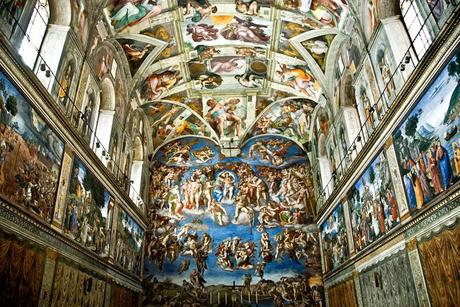Residing on the groundwork of an old chapel called the Capella Magna, the Sistine Chapel was rebuilt under the direction of Pope Sixtus IV and promptly renamed after himself. The dimensions of the Sistine Chapel are said to match those of Solomon’s Temple in Jerusalem and features some of the most iconic examples of the golden age of Renaissance art. Inspired by the stunning frescoes and sacredness of the site, the Chapel proudly claims to have an average viewing from over 5 million tourists each year.
Who painted the Sistine Chapel?
When thoughts of the Sistine Chapel arise, many are drawn to the distinctive art that is found on the ceiling by Michelangelo, however many other renowned artists also worked on the site. This factor has allowed the Sistine Chapel access to being titled one of the best-persevered buildings to date, with art that is considered a masterpiece throughout the ages. Botticelli is noted to have completed sections of the walls with three of his paintings being approved by Papa officials, as well as Rosselli and Ghirlandaio. A mere 27 years later, the sculptor Michelangelo was commissioned to paint the iconic ceiling frescoes of scenes from the Book of Genesis. Through his unique style of craftsmanship, an element that came about by his sculpting profession, he indirectly created a mode of painting that was then appropriated by many other artists to come.
How long did it take to paint?
Michelangelo’s frescoes famously took him 4 years to paint and led him to having permanent damage to his eyesight due to the amount of effort he placed into his work. Initially, he balked at the idea of having to paint the ceiling as his primary career was as a sculptor and was working on another project. However, he was commissioned by the Pope and completed the paintings in a short amount of time given the grandeur and difficult conditions he was placed over.
While the rumor of Michelangelo painting whilst on his back has circulated throughout the years, he designed and built his own scaffolding and was able to stand high above to paint. He frequently complained of being in pain due to the way he was standing and even wrote a sonnet humorously noting all of his aches and pains.
How to visit the Sistine Chapel?
You will need to pre-purchase tickets through the Vatican Museum to ensure you get a viewing, and we recommend visiting early in the morning to avoid the busy crowds. The Sistine Chapel is open Monday to Saturday all year, and the last Sunday of the month when it is free to visit. Keep in mind that there are restrictions when visiting the Chapel which must be strictly followed or else you won’t be allowed entrance. For a full list of rules, please visit the Vatican Museum webpage however some notable restrictions are that photography and filming are forbidden in the Sistine Chapel and immodest clothing is banned.
Be sure to check out our Vatican & Sistine Chapel Tour today!
Advertisements

